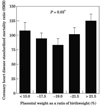Biological features of placental programming
- PMID: 27817870
- PMCID: PMC5278807
- DOI: 10.1016/j.placenta.2016.10.012
Biological features of placental programming
Abstract
The placenta is a key organ in programming the fetus for later disease. This review outlines nine of many structural and physiological features of the placenta which are associated with adult onset chronic disease. 1) Placental efficiency relates the placental mass to the fetal mass. Ratios at the extremes are related to cardiovascular disease risk later in life. 2) Placental shape predicts a large number of disease outcomes in adults but the regulators of placental shape are not known. 3) Non-human primate studies suggest that at about mid-gestation, the placenta becomes less plastic and less able to compensate for pathological stresses. 4) Recent studies suggest that lipids have an important role in regulating placental metabolism and thus the future health of offspring. 5) Placental inflammation affects nutrient transport to the fetus and programs for later disease. 6) Placental insufficiency leads to inadequate fetal growth and elevated risks for later life disease. 7) Maternal height, fat and muscle mass are important in combination with placental size and shape in predicting adult disease. 8) The placenta makes a host of hormones that influence fetal growth and are related to offspring disease. Unfortunately, our knowledge of placental growth and function lags far behind that of other organs. An investment in understanding placental growth and function will yield enormous benefits to human health because it is a key player in the origins of the most expensive and deadly chronic diseases that humans face.
Keywords: Birthweight; Chronic disease; Inflammation; Placenta; Programming; Trophoblast.
Copyright © 2016 Elsevier Ltd. All rights reserved.
Figures


Similar articles
-
Role of the placenta in fetal programming: underlying mechanisms and potential interventional approaches.Clin Sci (Lond). 2007 Jul;113(1):1-13. doi: 10.1042/CS20060339. Clin Sci (Lond). 2007. PMID: 17536998 Review.
-
Placental adaptive responses and fetal programming.J Physiol. 2006 Apr 1;572(Pt 1):25-30. doi: 10.1113/jphysiol.2006.104968. Epub 2006 Feb 9. J Physiol. 2006. PMID: 16469781 Free PMC article. Review.
-
[Impact of maternal obesity and diabetes on placental function].Med Sci (Paris). 2016 Jan;32(1):66-73. doi: 10.1051/medsci/20163201011. Epub 2016 Feb 5. Med Sci (Paris). 2016. PMID: 26850609 Review. French.
-
Placental Origins of Chronic Disease.Physiol Rev. 2016 Oct;96(4):1509-65. doi: 10.1152/physrev.00029.2015. Physiol Rev. 2016. PMID: 27604528 Free PMC article. Review.
-
The role of the placenta in fetal programming-a review.Placenta. 2002 Apr;23 Suppl A:S20-7. doi: 10.1053/plac.2002.0773. Placenta. 2002. PMID: 11978056 Review.
Cited by
-
Placental Erythroferrone and Erythropoietin mRNA Expression is not Associated with Maternal or Neonatal Iron Status in Adolescents Carrying Singletons and Adult Women Carrying Multiples.J Nutr. 2023 Jul;153(7):1950-1958. doi: 10.1016/j.tjnut.2023.05.023. Epub 2023 May 28. J Nutr. 2023. PMID: 37253412 Free PMC article.
-
Maternal iron nutriture modulates placental development in a rat model of fetal alcohol spectrum disorder.Alcohol. 2020 May;84:57-66. doi: 10.1016/j.alcohol.2019.11.003. Epub 2019 Nov 14. Alcohol. 2020. PMID: 31734307 Free PMC article.
-
Measuring intrauterine growth in healthy pregnancies using quantitative magnetic resonance imaging.J Perinatol. 2022 Jul;42(7):860-865. doi: 10.1038/s41372-022-01340-6. Epub 2022 Feb 23. J Perinatol. 2022. PMID: 35194161 Free PMC article.
-
The Effect of Maternal Exposure to Air Pollutants and Heavy Metals during Pregnancy on the Risk of Neurological Disorders Using the National Health Insurance Claims Data of South Korea.Medicina (Kaunas). 2023 May 15;59(5):951. doi: 10.3390/medicina59050951. Medicina (Kaunas). 2023. PMID: 37241184 Free PMC article.
-
Three-dimensional Rendering and Analysis of Immunolabeled, Clarified Human Placental Villous Vascular Networks.J Vis Exp. 2018 Mar 29;(133):57099. doi: 10.3791/57099. J Vis Exp. 2018. PMID: 29658922 Free PMC article.
References
-
- Barker DJ, Thornburg KL. The obstetric origins of health for a lifetime. Clinical obstetrics and gynecology. 2013;56:511–519. - PubMed
-
- Wilson ME, Ford SP. Comparative aspects of placental efficiency. Reproduction (Cambridge, England) Supplement. 2001;58:223–232. - PubMed
-
- Martyn CN, Barker DJ, Osmond C. Mothers' pelvic size, fetal growth, and death from stroke and coronary heart disease in men in the UK. Lancet. 1996;348:1264–1268. - PubMed
Publication types
MeSH terms
Grants and funding
LinkOut - more resources
Full Text Sources
Other Literature Sources
Medical

